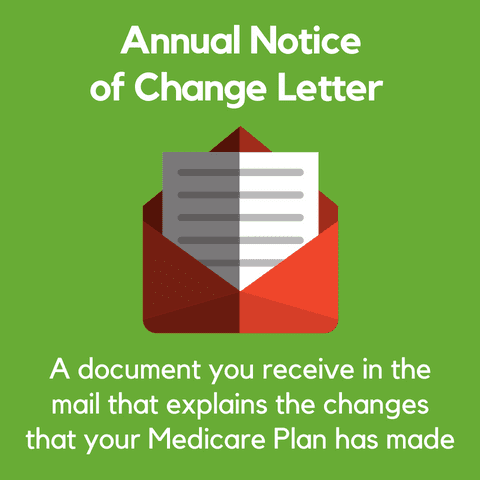3 things to know about the Annual Notice of Changes If you want to avoid surprises in the new year with your Medicare coverage, pay attention to the details.
1. First of all What is it?If you have a Medicare Advantage, A Cost or Drug plan, the Annual Notice of Changes (ANOC) tells you about changes to your current Medicare plan benefits and costs that will take effect Jan. 1. These letters typically look like any other junk mail you start getting around the Medicare Annual enrollment period, so it is important to be mindful and on the lookout for it. So I recommend that every September you keep an eye for mail from your Medical insurance provider in particular. Sometimes this task is daunting due to the high number of advertisements coming in the mail, nevertheless being proactive here can really be important.
Changes to premiums, covered services and costs
Typically you will see a side by side comparison of what you have and what it will be in the new year. You obviously want to pay attention to plan increases in cost.
- Premium (the amount you pay each month)
- Deductible (the amount you pay before your plan kicks in)
- Copay (a flat fee that you pay for each service)
- Coinsurance (as opposed to a flat fee, this is a percentage you have to pay for each service)
- Maximum out-of-pocket cost (the most you’ll have to pay for covered expenses in a given year before your plan begins to pay 100 percent, including your deductible, copays or coinsurance)
This list will include new services that will be covered, services that will no longer be covered, and changes to coverage of existing benefits. Ex.( dental, vision, hearing, gym memberships) these are popular benefits that often get added or subtracted from the plan benefits.
Changes to drug coverageIf you have Medicare Part D (prescription drug) coverage, your plan’s drug list (formulary) will most likely change as new medicines are added and certain medicines are moved to a different cost tier or removed from the list.
A lot of times this is where people fail to pay close attention and have surprises about drug costs, when they first go to the Pharmacy in January for the first time. In most cases they are not good surprises, and if you are on a stand alone part D drug plan it is not easy to change after your annual election period. It will require a SEP also known as a special enrollment period.
Changes to your provider and pharmacy networkYou’ll want to make sure your doctor, hospital, pharmacy and other health care providers are still on the list of providers your Medicare plan will help pay for (network). Your ANOC will most likely say that there are changes, but you’ll have to check your plan’s provider and pharmacy directories to find out exactly what changed. Your ANOC packet will include information on how to access the directories online or how to order a paper copy. This can be a big deal when it comes to both Medical providers and pharmacy, we all like to see doctors we are comfortable with and no one likes to be told sorry we don\’t accept your insurance. Finding out that your favorite pharmacy no longer accepts your plan or is no longer preferred option is not enjoyable either!( All of this can be avoided by reviewing the annual notice of change letter and reviewing options with your agent.)
2. When does it arrive?You should receive your ANOC in the mail (or by email, if you’ve signed up for paperless delivery) by Sept. 30. The key dates to remember:
3. What do I have to do when I get my ANOC? To prevent surprises in January, you should review your ANOC and understand the changes being made to your plan. If you have a friend or family member who’s had problems with their current plan, check with them to see if they need help understanding the changes.
- Review the benefit and cost changes and contact your plan if you need help understanding what the changes mean to you.
- Check the drug formulary to make sure the drugs you’re currently taking are listed and what costs apply to the assigned drug tier.
- Check the provider and pharmacy directories to make sure your doctor and pharmacy are still in your plan’s network.
- If you decide your current plan no longer meets your needs, contact the plan to see if they have other options that may be a better fit. Also, you can visit medicare.gov and use the Medicare Plan Finder to compare plans available in your area.
This time of year is always a good time to speak with your agent or broker especially if you have different medical or prescription drug needs. These letters are supposed to be sent out to help you understand all the plan changes but many of my clients have said they do not understand these letters . If that is the case for you I would encourage you to reach out to your Medicare agent or broker to discuss your needs and the upcoming plan changes to make sure you are still in the most suitable plan for you. If for some reason you do not have someone to help guide you please feel free to reach out to our office and we will set you up with a friendly agent to review your current coverage and make sure you are still in the appropriate plan for your needs.
So just to recap, every September Medicare advantage, along with Medicare cost & part D plans will receive a letter or sometimes an email if you opted for paperless documents. This letter is called the Annual Notice of change, and in this letter you will find all the good, bad or indifferent plan changes for the new year. We really want to play extra close attention to premium increases, deductible increases and any other cost sharing increases for that matter. Besides that you always want to make sure your provider network still works for you and of course that all of your monthly prescriptions are still covered and under the same tiers that you are at now.






